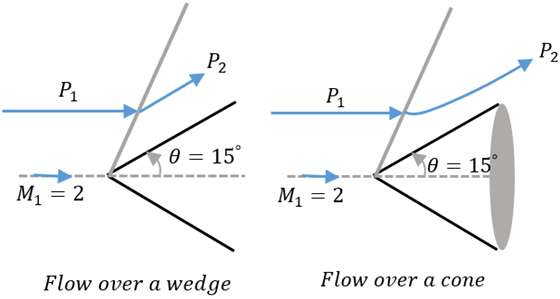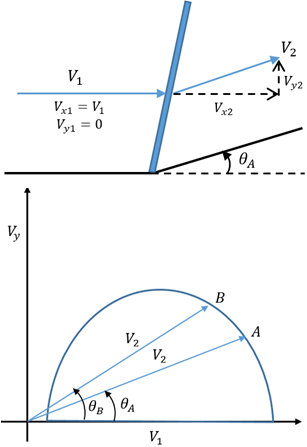This set of Aerodynamics Multiple Choice Questions & Answers (MCQs) focuses on “Physical Aspects of Conical Flow”.
1. Conical flow is an example of which of these flows?
a) Axisymmetric flow
b) Two – dimensional flow
c) Flow symmetrical about x – z plane
d) One – dimensional flow
View Answer
Explanation: The conical flow is symmetric about a particular axis hence its flow properties such as pressure, density remain the same in plane which passes through a symmetric line. The flow properties depend only on radius r and the axis hence it is known as axisymmetric flow.
2. The flow stream behind the shock in a conical flow is parallel to the conical surface.
a) True
b) False
View Answer
Explanation: Unlike the flow over a wedge which is a two – dimensional flow, the streamline is not parallel to the surface behind the shock wave. The flow field between the shock wave and the conical surface is not uniform causing the streamlines to becomes slightly curved as the pressure is not constant the conical surface.
3. 3D relieving effect is a consequence of which of these flows?
a) Flow over a wedge
b) Flow over a flat – plate
c) Flow over a cone
d) Flow over a flat plate kept at 90 degrees
View Answer
Explanation: Since the pressure over the conical surface is not constant unlike the flow over the wedge, the streamlines tend to curve behind the shock wave. The 3 – dimensional nature of conical flow provides the streamlines with an extra space relieving any obstruction from the surface of the body. This is known as 3D relieving effect.
4. For a wedge and cone of same half angle, the shock wave formed at the cone is weaker.
a) True
b) False
View Answer
Explanation: One of the consequences of 3 – dimensional relieving effect in a cone is that the shock waves formed are weaker in comparison to the waves formed over the wedge with same half angle kept at the same incoming flow velocity.

5. What is the application of studying conical flow?
a) Re-entry shuttle
b) Boeing A – 320
c) Flow over flat plate in wind – tunnel
d) Hot – air balloon
View Answer
Explanation: Any object which has blunt conical nose at the front end travelling at high supersonic speeds such as re-entry vehicle, missiles have formation of shock waves. Thus, studying conical flow is of great significance.
6. What is the shape of the shock wave formed over a cone in a supersonic flow?
a) Normal shock
b) Conical shock
c) Straight shock
d) Triangular shock
View Answer
Explanation: When a cone having semi vertex angle θc is kept in an incoming supersonic flow, then there is a formation of shock wave. This is an oblique shock wave which has the shape of the cone and the streamlines downstream of the shock are not immediately parallel to the surface.
7. What information does the shock polar provide?
a) Oblique shock properties
b) Normal shock properties
c) Shock angle
d) Intensity of shock
View Answer
Explanation: Shock polar is graphical representation of all the properties of the oblique shock waves. It is the locus of all the possible velocities behind the shock wave. The downstream velocities are plotted on the y – axis and the upstream velocities are plotted on the x – axis.
8. What happens to the velocity downstream of the shock as the deflection angle increases?
a) Remains same
b) Increases
c) Decreases
d) Tends to infinity
View Answer
Explanation: Using the shock polar, we notice that as the deflection angle is increased from θA to θB, the downstream velocity magnitude decreases due to the formations of stronger shock wave.

9. The flow properties remain constant in a conical flow over which of the following?
a) Ray from a vertex
b) Along the axis
c) Along the conical base
d) Interior of the conical surface
View Answer
Explanation: Flow properties such as the pressure and density remain constant along the ray originating from the vertex of the cone including on the surface of the cone. Although, the flow properties vary from one ray to another.
10. If a cone with half angle 30.2 degrees is kept in a flow at Mach number 3.5, then what is the value of Mach number downstream of the shockwave?
a) 1.110
b) 2.482
c) 1.648
d) 3.45
View Answer
Explanation: Given, M1 = 3.5,θ = 30.2°
From the θ – β – M curve,
For M1 = 3.5 and θ = 30.2°, the value of β is 48°
Normal component of M1 is Mn1 = M1 sinβ = 3.5 × sin48 = 2.60
From the normal shock table (gas table), for Mn1 = 2.6, we get
\(\frac {P_{02}}{P_{01}}\) = 0.4601 and Mn2 = 0.5039
Thus the Mach number downstream of the shock wave is
M2 = \(\frac {M_{n2}}{sin(β – θ)} = \frac {0.5039}{sin(48 – 30.2)}\) = 1.648
Sanfoundry Global Education & Learning Series – Aerodynamics.
To practice all areas of Aerodynamics, here is complete set of 1000+ Multiple Choice Questions and Answers.
If you find a mistake in question / option / answer, kindly take a screenshot and email to [email protected]
- Check Aerodynamics Books
- Practice Aeronautical Engineering MCQs
- Practice Aerospace Engineering MCQs
- Check Aeronautical Engineering Books
- Check Aerospace Engineering Books
